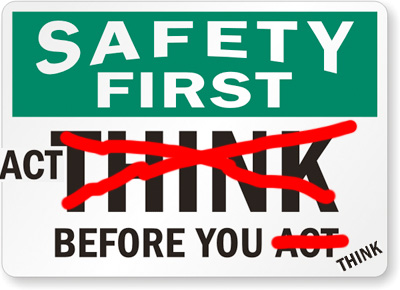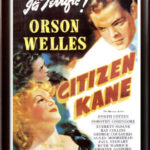“Nothing will be achieved if first all objections must be overcome” said the wise Eleanor Roosevelt. Objections prevent action. Objections to our own actions are ultimately authored by ourselves. Others may advise caution or object, but it takes us to take on board and own those objections to prevent us from acting. It is our thoughts prior to action that can ultimately present a formidable barrier to action.
Thinking before you act is what we’ve been all brought up to do. We are taught to think a failure to think first must ultimately result in reckless disregard for our own or others’ well-being. The trouble is, thinking before you act is not a fail safe process, because it is impossible to think through all the possible outcomes of a proposed action.
We cannot work out all the possibilities in advance, not only because there are too many, but also because our current vantage point may not reveal the complete picture. I live near the coast, and if I am standing on one beach I cannot see the other one around the headland. Even if I stand on that headland, where I can see both beaches, I cannot see around the next headland and what may be on offer there. In other words, I might be missing out on a fantastic beach and I’ll never discover it unless I am prepared to act.
For people stuck in their careers, there is every likelihood that their heads are full of confusion, cautionary thoughts and frustration. Clarifying their thoughts as a lot of coaching and counseling aims to do, may be doing no more than giving them a sharper picture of the beach they are on. They will never fully appreciate the other great beaches until they are prepared to act and move to a new vantage point. Act before you think!
I am more and more convinced that we’ve got our priorities wrong by so strongly privileging thinking before you act in career coaching. I become even more convinced when I hear the countless stories from clients who “fell into” satisfying careers, or got there by being in the right place at the right time. These people (and I think they are the majority) got where they are as much by acting before you think, than thinking before you act.
So in your own coaching practice, take action, and resolve to encourage your clients to action first, and then collectively reflect after. Encourage lots of small steps and little experiments, encourage turning up to things, encourage connection with others without any clear agenda, encourage random acts of contribution to others, encourage your clients to go forth.
Related Posts









Aren’t you in danger of propagating a little bit of black-and-white thinking? Surely it’s not a case of either think-before-you-act or act-before-you-think in every case. Doesn’tit depend on the situation? Sometimes a rethink-before-you-act allows someone to change their perspective or assumptions before conducting experiments. Otherwise, they may fail to spot the new opportunities offered by the experiment because they are using an old mindset.
Part of the problem is that you are using only one definition of ‘think’, namely reflection for action’
Thanks for the comment David. I wondered about the pendulum attractor thinking myself which is why I used the terms “so strongly” and “as much by” – which rescue me from the rocky shores of absolutism! I am not advocating replacing one with the other.
Nor am I limiting thinking to mean reflection for action. I am arguing that there are limits to ALL forms of thinking, and that thinking is broadened, moderated, challenged, complimented and enhanced by action. Could to be drawn out on these points, thanks again.
…sorry. I hit Publish before I was finished!
Reflection for action = anticipating your needs before acting.
However, this isn’t the only type of thinking. There is also ‘reflection on action’ – looking back at past experiences and extracting new meaning from them (perhaps by counterfactual thinking).
Finally, there is ‘reflection in action’ – taking an external perspective as you act which allows you to modify your understanding and behaviour on the fly. I know you have talked in the past about improvisation. Surely this thinking and acting in harmony is what people should be aiming for in order to cope with the rapidly changing working environment. In order to achieve this mindful, improvisational approach don’t people have to practice both thinking-before-acting and thinking-after-acting?
When working with clients I try to suss out whether they are more of an impulsive ‘act with little thought’ type person in this domain or a ruminative ‘don’t act until you think you know what you’re doing’ type person. If there is a consistent pattern, I gently try to encourage them towards a more balanced approach.
Pingback: Coaching Fractal Action for Personal Development | The Factory
David I think it is a great idea to take cognizance of how your client approaches opportunity or risk in taking action. Not sure if these are necessarily always best considered in terms of types, rather they may be more state-based responses to life events than underlying traits. For instance the outgoing, venturesome person who suffers a significant personal set-back (for instance a major injury) and becomes withdrawn, overly cautious and self-limiting. That said, in your terms my call to action is certainly aimed at those who have low opportunity awareness (as measured with the Luck Readiness Index http://www.jimbright.com/tests).
My general point is for us to consider new ways of partnering/ facilitating/ coaching/ coaxing our clients into taking action, and being there to help them reflect on the outcomes. My feeling is that career development is still dominated by an approach of delivering everything in one single session or very few measured in hours – as opposed to many measured in minutes over a longer time.
A move to the latter kind of model increases the opportunities to partner clients in change and to conduct more on-going reflection. I think I am going to experiment in offering such a service.
I would be interested in hearing more about your thoughts on the tendency of our profession to ‘deliver’ in a session or block of sessions and moving beyond this in new ways. Although many career coaches offer support-on-demand between sessions (eg by email or tel-call), the ‘session’ approach dominates much of what career coaches do when working with individuals.
Life’s uncertainties do bring unexpected moments of choice and opportunity: a single word can change everything. But with technology, we and our clients are ‘always on’ (AOPs, Always On Professionals): we have live, pre-recorded media and personal interaction at our fingertips in the form of sound, video, text. Since technology affords new ways of communicating at low/no cost (apart from our time creating or participating), how do you think we might shape services that are more responsive to clients’ life events?
David, just following up on your point about improvisation. Yes I agree entirely. My concern is that the way a lot of career coaching is arranged, there are not as many opportunities for the harmony of action and thought. Lots of time to reflect on action, to imagine action etc, but far less time out of the simulator and actually flying!
Pingback: Creating creative coaching sessions | The Factory